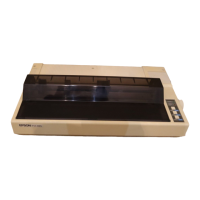use the same technique to produce the plus-or-minus symbol:
10 LPRINT CHR$(27)"S0+"CHR$(8);
f
Plus/minus
20 LPRINT CHR$(27)"S1-"
30 LPRINT CHR$(27)"@"
#
How about that, and it only took three lines. Next try this approxi-
mately equally short program:
10 LPRINT CHR$(126)CHR$(8);
f
Approximately equal
20 LPRINT CHR$(27)"J"CHR$(ll)CHR$(126)
30
LPRINT
CHR$(27)"@"
This program prints CHR$(126), a diacritical mark used in Spanish
that is called a tilde. You backspace the print head by using CHR$(8),
then force a partial line feed by using Escape” J”CHR$(ll). The FX
prints the second tilde just below the first one to form the desired
figure.
offsets
The backspace function works in all pitches, which opens up some
interesting possibilities. To see what happens when you mix backspac-
ing with different pitch modes, we’ve prepared a special program that
shows off the backspace function in two passes: first in Pica and then
in Expanded Pica. We cause all backspacing to be done in Compressed
Mode to create a slight offset. Enter:
NEW
10 FOR J=0 TO 1
20 LPRINT CHR$(27)"W"CHR$(J); ' Expanded when J=l
30 LPRINT "BACKSPACES"CHR$(l5); 'Compressed
40
FOR X=1 TO 17: LPRINT CHR$(8);: NEXT X
50 LPRINT CHR$(18)"BACKSPACES" ' Compressed off
60 NEXT J: LPRINT CHR$(27)"@" ' Reset
and RUN the program.
82

